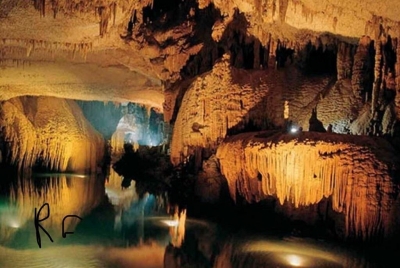
|
The 8.2-m-long limestone stalactite thought to be the longest in the world is in Jeita Grotto, a limestone cave complex, 18 km north of Beirut, the capital of Lebanon. It was discovered in 1836. |
Jeita grotto, a monumental underground karstic wonderland and also the water source for over a million citizens of Beirut, is about 18 kilometers north of the Lebanese capital. It is an extraordinary site which could be one of the wonders of the world but remains an intimate experience. It is a system of two separate, but interconnected, karstic limestone caves spanning an overall length of nearly 9 kilometres, making it the longest cave system in the Middle East. The Lower Cave is home to an underground river some 6.2 kilometers long, while the Upper Cave features innumerable dazzling rock formations including one of the largest hanging stalactites in the world, measuring 8.2 metres (27 feet).
Credit: Indosphere
Picture Credit : Google
